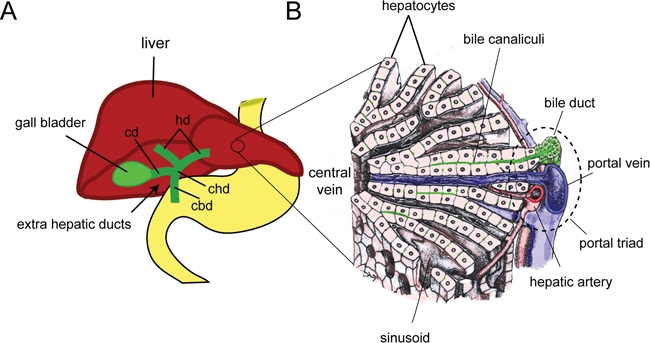The key difference between hepatic bile and gallbladder bile is that hepatic bile is the bile that is produced continuously by the liver to aid the digestion of food, while gallbladder bile is the bile that is stored and concentrated in the gallbladder until it is needed during the digestion of food.
Bile is a dark green to yellowish fluid produced by the liver that aids the digestion of lipids in the small intestine. In most vertebrates, it is produced continuously by the liver and normally stored in the gallbladder until the digestion of food. After eating, this stored bile (concentrated) comes into the duodenum to break down lipids in the food. Therefore, hepatic bile and gallbladder bile are two forms of bile in the body.
CONTENTS
1. Overview and Key Difference
2. What is Hepatic Bile
3. What is Gallbladder Bile
4. Similarities – Hepatic Bile and Gallbladder Bile
5. Hepatic Bile vs Gallbladder Bile in Tabular Form
6. Summary – Hepatic Bile vs Gallbladder Bile
What is Hepatic Bile?
Hepatic bile is the bile that is produced continuously by the liver to aid the digestion of food. It is a secretion of the liver. The composition of hepatic bile is water (97–98%), bile salts 0.7%, bilirubin 0.2%, fats 0.51%, and inorganic salts 200 meq/l. The fats of hepatic bile are composed of cholesterol, fatty acids, and lecithin. The two main pigments of hepatic bile are bilirubin and biliverdin. Bilirubin is orange to yellow in colour, and its oxidised form is biliverdin. Biliverdin is green in colour. When both are mixed together, they are responsible for the brown colour of feces. The liver produces about 400 to 800 millilitres of bile per day in adult human beings. The hepatic bile is alkaline on average (pH 7.50 to 8.05). Due to its alkaline nature, it has the function of neutralizing excess stomach acid of the chyme.

Figure 01: Structure of the Liver
Bile acts as a surfactant to some extent, and it helps to emulsify the lipids in food. Bile salts are anions. They are hydrophilic on one side and hydrophobic on the other side. They aggregate around droplets of lipids and thus form micelles. The dispersion of fats of food into micelles provides a greatly increased surface area for the action of the enzyme pancreatic lipase that breaks down lipids more easily. Besides the digestive function, bile also serves also as the route of excretion for bilirubin, a by-product of recycled red blood cells. Bile also helps the absorption of fat-soluble vitamins such as the vitamins A, D, E, and K. Moreover, bile salts act as bactericides that kill bacteria in the food.
What is Gallbladder Bile?
Gallbladder bile is the bile that is stored and concentrated in the gallbladder until it is needed during the digestion of food. The gallbladder serves as a reservoir for bile produced in the liver. Bile is initially secreted from hepatocytes into the common hepatic duct. As the common hepatic duct descends, it joins with the cystic duct, which allows bile to flow in and out of the gall bladder for storage and release. At this point, the common hepatic duct and cystic duct combine together to form the common bile duct. The common bile duct carries gallbladder bile into the duodenum, which is the upper part of the small intestine.

Figure 02: Gallbladder Bile
When a person eats, the gallbladder releases bile into the common bile duct, where it carries to the upper part of the small intestine (duodenum) to help break down fats in food. Sometimes, in pathological conditions, the cholesterol in gallbladder bile will occasionally accrete into lumps. Thus, it forms gallstones. Moreover, the longer a person does not eat, the bile in the gallbladder becomes more acidic. Usually, the gallbladder bile is acidic (6.80 to 7.65). Further, the phosphorus and protein concentration in gallbladder bile is specifically much higher.
What are the Similarities Between Hepatic Bile and Gallbladder Bile?
- They are two types of bile in the body.
- Both types of bile secrete into the common bile duct.
- Liver produces both types of bile.
- Both are carried into the upper part of the small intestine (duodenum) in the presence of food.
- The function of both types is facilitating the digestion of fats in food through emulsification.
What is the Difference Between Hepatic Bile and Gallbladder Bile?
Hepatic bile is the bile that is produced continuously by the liver to aid the digestion of food. On the other hand, gallbladder bile is the bile that is stored and concentrated in the gallbladder until it is needed during the digestion of food. So, this is the key difference between hepatic bile and gallbladder bile. Furthermore, hepatic bile is alkaline in nature, while gallbladder bile is acidic in nature.
The following infographic summarizes the differences between hepatic bile and gallbladder bile in tabular form.
Summary – Hepatic Bile vs Gallbladder Bile
Bile is also called gall. It is a greenish-yellow secretion. There are two forms of bile in the body: hepatic bile and gallbladder bile. Hepatic bile is the bile that is produced continuously by the liver. On the other hand, gallbladder bile is the bile that is stored and concentrated in the gallbladder. Thus, this is the summary of the difference between hepatic bile and gallbladder bile.
Reference:
1. “Bile.” An Overview | ScienceDirect Topics, www.sciencedirect.com/topics/medicine-and-dentistry/bile.
2. “Gallbladder and Bile Duct.” Mayo Clinic, Mayo Foundation for Medical Education and Research.
Image Courtesy:
1. “Cellular architecture of the liver” By Zorn, A.M., Liver development (October 31, 2008), StemBook, ed. The Stem Cell Research Community, StemBook, doi/10.3824/stembook.1.25.1 (CC BY 3.0) via Commons Wikimedia
2. “Gallbladder Anatomy” By LukesAnatomy – Own work (CC BY-SA 3.0) via Commons Wikimedia
ncG1vNJzZmivp6x7pbXFn5yrnZ6YsqOx07CcnqZemLyue8OinZ%2Bdopq7pLGMm5ytr5Wau260xKmYraGTYq%2BquMRmmKecXZyurbjBpZidnJWneqO1y55m